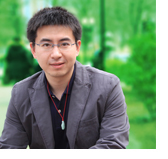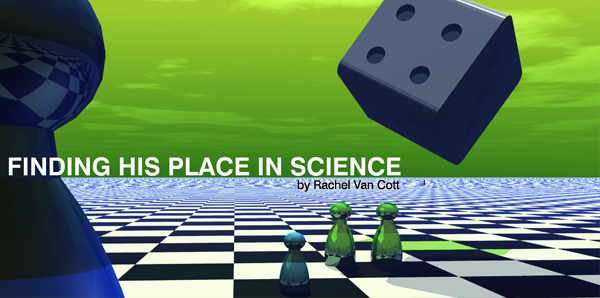When Ying Liu was in middle school, physics was his favorite subject. So he naturally took part in the province-wide Physics competition near his hometown in China. The competition was a set of challenging written exams full of interesting questions, Ying said, and when it was all over, he had the highest score of all the students in Shangdong Province. He didn't realize it then, but when he won that competition, Ying took a definite step toward his future in science. After the competition and another round of selection examinations, Ying was picked to be part of a experimental high-school program in Beijing that offered a targeted science education. He had access to university classes, and he didn't have to worry about preparing for the stressful national college entrance exam. So while the other students in his age group feverishly studied for a test that would determine the course of their years at university, Ying was encouraged to pursue his scientific interests. When he was admitted to Tsinghua University, Ying decided to study electrical engineering, in part because it was a mixture of his favorite, familiar high school subjects: physics and mathematics.
Now that he's a graduate student working towards his PhD at LIDS, Ying has an arsenal of more specific, technical phrases to describe what occupies his mind. He's currently working on solving "inference in Gaussian graphical models". More plainly, Ying and researchers like him are trying to use mathematics to describe real-world systems, so that they can make estimations and predictions. It sounds like a straightforward idea, and in some cases it is—the way a ball falls to earth after it's thrown, for example, can be illustrated by plugging variables into a relatively simple set of formulas. But for more complicated scenarios, researchers don't have a simple equation to explain what's going on. In those situations, they need to create probabilistic graphical models to describe how the system operates—nodes represent variables, and edges between nodes represent their dependencies. Some edges are linked to just one other node. Others are linked to a large number of neighboring nodes. To retrieve useful information from the graphical models, messages start at one node and are passed around the graph through edges until the process produces an answer. This approach is called belief propagation. However, this distributed approach might not work if the graph contains loops—where messages may change and circulate forever. If that's the case, the system never gets to a stopping point, or the final answer. Ying's research offers a solution for that specific problem. His work proposes a method called feedback message passing, which identifies a set of special nodes that are responsible for these never-ending cycles. A specific message-passing scheme is used for these nodes while other common nodes use the standard belief propagation. By carefully selecting the set of special nodes accurate solutions can be obtained. This work has the potential to provide a new way to find a solution in a field where researchers are always looking for a better way to predict more accurate solutions to inherently complex problems. This makes Ying part of the community of researchers that are constantly engineering new ways to look at the world.
But Ying couldn't always see how he fit into the world of scientific research. Back in his early undergraduate years, he wasn't sure if and how he'd be able to contribute to the scientific community. It wasn't on his radar yet. He loved learning and uncovering new ideas, but didn't really know how to get down to research. "In my early undergrad years, I don't think I specifically tried to do research because I—well as long as you have some good things to learn and you feel like you are improving every day, you are very happy." Ying said. Thanks to the rigorous program in Tsinghua University, Ying gradually built up his knowledge base. However, the textbooks that Ying studied were authoritative, and he didn't have much exposure to current scientific research or papers. So he didn't see the process and papers behind the theories that he was being taught. But when he participated in a semester-long undergraduate exchange program in Hong Kong, something came together in his mind. "The professors gave us material, a link to a paper, many good references... I think that was my first time to read an academic paper." Suddenly, it clicked. The ideas contained within textbooks weren't incontrovertible rules. They were constantly evolving theories. Now Ying recognizes science as the product of real researchers who pushed the boundaries of knowledge and tried new techniques. That idea of science—as the ever-changing product of a vibrant community of researchers—sounded like something he could work with. After Ying returned to Tsinghua University, he immediately participated in an extracurricular research project of automatic video scene retrieval, giving him the chance to formulate some of his first real research problems. That's also when he decided to apply to a PhD program. If you can explore and explain even a small problem, said Ying, you give everyone a chance to understand the world just a bit better. "I wanted to come to MIT and see how great research happens, how things are converted into part of the human heritage," said Ying.
He's happy with his choice and the experiences that he's had since then. He particularly values working with his advisor, LIDS director Alan Willsky. Willsky, Ying said, is a brilliant mentor. "In my first group meeting, it was my first time explaining research in English, so I was worried that Alan wouldn't be able to understand me," said Ying, "but he understood me very well, not because my English was good, but because he's quick at thinking." The Stochastic Systems Group that Ying works in is split into sub-groups of two or three researchers who are working on closely related topics. Those "grouplets" meet with Professor Willsky every week. "I think it's a good balance of individual meeting and big group meeting. In a big group meeting you cannot get other people's attention... the time is not efficiently used. If it's an individual meeting you'll never know what other people are thinking, how they are doing their research," said Ying, "In the form of grouplets, we are making a very good trade-off."
Outside of work, Ying spends recreational time with his friends both in and outside his research group. They hit the gym together, or play ping-pong on the game table just outside the lab. The rich community is one of the best things about working at LIDS, Ying said. When you're working on incredibly complex problems, sooner or later everyone gets stuck. And when you do, you need a supportive community of your peers to prod you in new directions. "I still remember in the first summer, right after the academic year, I was trying to get the main point of my master's thesis for a whole three months and I didn't solve anything," Ying said. He wrestled with the research topic for months and then, in one afternoon, he suddenly recognized the main point. Ying's not sure how he would have made it through those rough months without his friends. "People around you help you pass the difficult times...when you need some encouragement or help to discipline yourself, to care about some new ideas. That's the great part of MIT," said Ying, "When you get stuck on something, you can talk to people. They may not help you directly solve the problem, but they can help you explore various directions one by one." For now Ying's putting his energy into completing his master thesis and connecting his work to various applications. After the master thesis is done, Ying will move on to his PhD work. It's hard to see where he's headed after that, he says, "but I always have academia in my mind."




